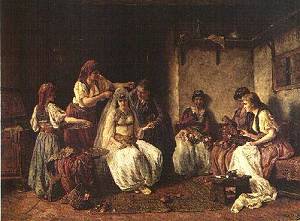
Jus Primae Noctis |
Pravo prve bracne noci |

Paja Jovanovic, Kicenje neveste / Adornment of the Bride
| Jus primae noctis or droit du seigneur is actually the right to sleep with a nubile (young and sexually attractive) servant before turning her over to her servant husband (the right by which a landlord may sleep first night with the bride of a newly married serf), although the custom maybe avoided by the payment of a fine. | Jus primae noctis ili droit du seigneur je pravo prve bracne noci, zapravo pravo bega (ili rjedje age) da provede jednu noc sa buducom zenom svoga kmeta (mladom i seksualno privlacnom) nakon cega bi je predao dalje kmetu, iako se ovo moglo izbjeci otkupom (placanjem izvjesne sume novaca). | |
| The plot of the opera Le Nozze di Figaro (The Marriage of Figaro) by Wolfgang Amadeus Mozart is mainly based on the Jus primae noctis. Figaro and Susanna are to be married but Count Almaviva the lord of the castle near Seville in Spain will take advantage of the Jus primae noctis and spend a night with the bride. | Zaplet u operi Le Nozze di Figaro (Figarova zenidba) od Wolfganga Amadeusa Mocarta je zasnovan na pravu prve bracne noci. Figaro i Susanna se spremaju za vjencanje ali grof Almaviva gospodar dvorca kraj Sevilje u Spaniji zeli da iskoristi svoje pravo i provede jednu noc sa Sussann prije Figara. | |
| This right was widely practiced in Europe especially in countries under the Ottoman rule (provinces of the Ottoman Empire were: Greece, Bulgaria, Serbia, Bosnia) until the very end of the 19th century. | To pravo je siroko praktikovano u Evropi i posebno u zemljama Otomanske Imperije (provincije Otomanske Imperije su bile: Grcka, Bugarska, Srbija, Bosna) sve do kraja devetnaestog vijeka. | |
| The right held itself to the end of the 19th century in Russia. In America this right (unofficial) existed up to the civil war with the slave holding of the American Southern States. | To pravo je prestalo u Rusiji u XIX vijeku. U Americi je to pravo (nezvanicno) postojalo sve do gradjanskog rata u vezi sa robovlasnistvom u juznim drzavama u Americi. | |
| The picture, painted by Paja
Jovanovic, shows a bride preparing for the wedding night.
The first night he is going to spend with her landlord.
Landlords (beg, aga) were usually from Turkey but there
were many local noble birth converted to Islam to save
their privileges when the region was controlled by the
Ottoman Empire. * The right was used on a braid of a feudal dependant or servant. They were Christians and the right wasn't used on Muslim brides. On the day before her wedding the young Christian bride will be visited by a representative of the landlord (beg, aga). The representative is usually accompanied by a file of soldiers. The representative takes the bride to the house of the landlord for a day and a night, and returns her to her home at dawn on the wedding day. |
Na slici, koju je naslikao
Paja Jovanovic, prikazana je mlada koja se priprema za
prvu bracnu noc. Tu prvu noc ce provesti kod bega. Begovi
su obicno bili Turci mada je bilo lokalnog plemstva koje
je preslo na Islam da sacuvaju svoje privilegije za
vrijeme vlasti Otomanske imperije nad Balkanom. * Pravo prve bracne noci je vazilo za mlade kmetova ili slugu. One su bile hriscanke (vlahinje) jer muslimani nisu bili kmetovi. Na dan udaje hriscanska (vlaska) mlada bi bila posjecena od strane jednog begovog (aginog) predstavnika obicno u pocasnoj pratnji jednog odjeljenja vojnika. Predstavnik bi zatim odveo mladu do begove (agine) kuce gdje bi provela dan i noc a zatim bi je otpratio nazad njenoj kuci u jutro na dan vjencanja. |
|
An interesting detail on the picture is that all women on the picture are dressed in traditional oriental (Turkish style) clothing. Under the Ottomans textile styles has influenced by Islamic tradition. Even present-day words for textiles are often derived from the Islamic world, such as damask from Damascus. Women wore "dimije" (it looks like baggy trousers) of thin, often gold-woven, silk brocade, emphasizing the female figure. In Islamic countries, both men and women continue to follow tradition, concealing their hair in public under headcloths, turbans, fezzes, or veils. Women on the picture except the one on the right have their hair covered with a shawl (also called shamija or mahram) according to the Islamic custom. |
Ono sto je zanimljiv detalj
na slici je da su sve zene na slici obucene u
tradicionalnu orjentalnu odjecu turskog stila. Za vrijeme
Otomanske vlasti stil oblacenja je bio pod uticajem
islamske tradicije. Cak i danas se koriste nazivi
tekstila nastali u islamskom svijetu kao na primjer
damast po gradu Damasku. One nose dimije (koje lice na siroke hlace) od tankog cesto zlatno prosaranog tkanja koje isticu zensku figuru. U islamskim zemljama i muskarci i zene nastavljaju da slijede tradiciju pokrivajuci kosu u javnosti nekim pokrivalom za glavu: turbanom, fesom, velom. Zene na slici osim one na desoj strani imaju pokrivenu kosu salom (zvanim i samija, marama) u skladu sa islamskim obicajima. |
28th May 1998.